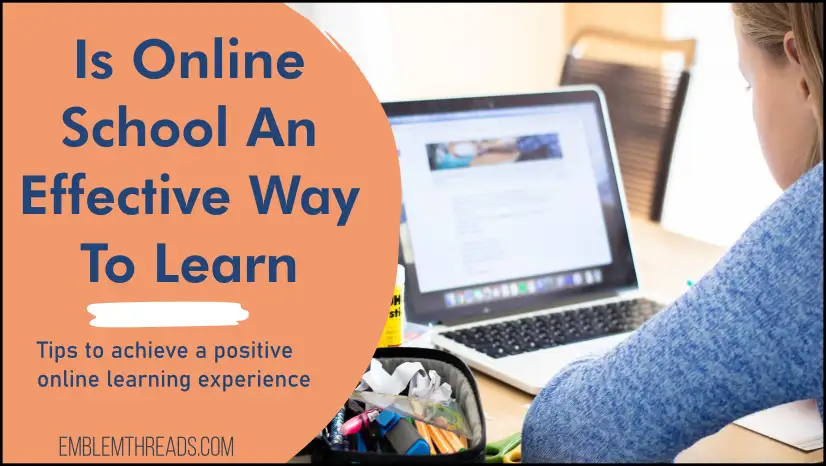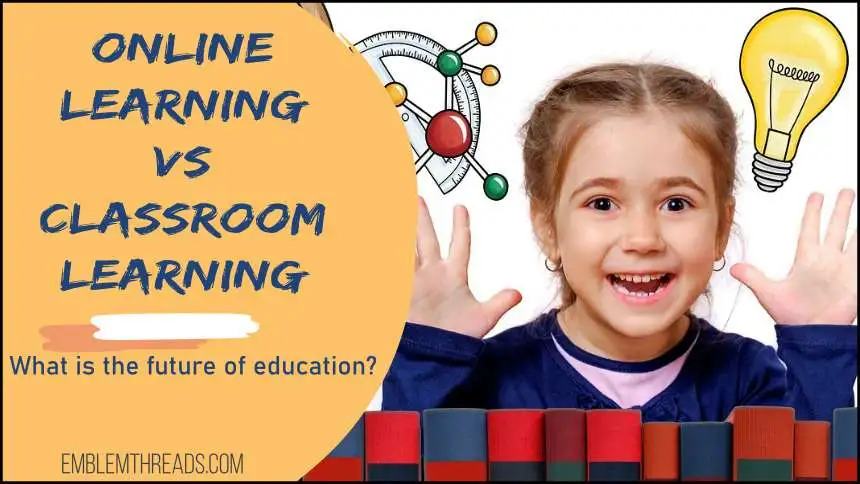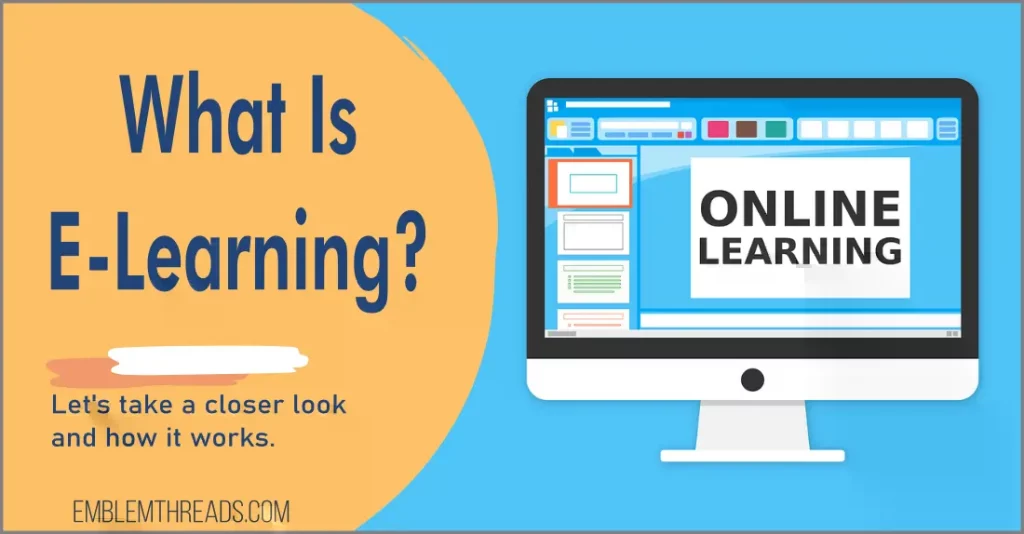For an online school to be an effective way to learn, a student needs to be an active participant, capable of staying focused, and able to work without constant supervision.
There are of course strengths and weaknesses of online schools that we will explore in this article. I will also make a distinction between elementary-age school children and university-level students, as online learning is vastly different between those groups.
How Effective Is Online Learning?
Effective Compared To What?
How do we measure the effectiveness of online learning? Does a gold standard exist to compare it to? Face-to-face, in-classroom learning is the natural comparison, but even that pedagogy does not always produce the best results.
Students, teachers, and schools all vary is the point.
It’s not an either-or proposition. Developing effective coursework for online eLearning as well as classroom in-person learning is the aim. The goal being well-rounded students capable of critical thinking.
The effectiveness of online learning depends greatly(though not solely) on the individual student. The age and maturity of the student are crucially important when making a decision about enrolling in online learning courses.
I wrote a whole article about online learning vs. classroom learning, including what the future of education might look like. See that article for the pros and cons of each teaching model. This article will focus on the effectiveness of online schools.
Also Read: Is It Education Or Politics? The Political Ramifications of Education
K-12 And University Online Education Differences
K-12 schools typically offer online instruction as a more personalized experience for their young students. This differs from university-level online classrooms as they more often use Massive Open Online Courses, or MOOCs as their model.
These are generalities of course, as I said above, every course and classroom is different. But typically K-12 schools need to provide a more structured environment with guidance and motivation. That is, more hand-holding.
Online K-12 classes mostly resemble traditional classes with teacher-led coursework and student interaction.
University students should have learned how to learn by this age and have a decent amount of discipline and self-motivation. Online courses for this group are more like a lecture style.
Interestingly, online learning college students report they miss the interaction and personalized experience that was part of their in-person classes. Maybe these classes could be structured more like the K-12 style.
University students need self-motivation and discipline for more lecture-style online classes presented to them.
Flexibility and choice.
Another difference between K-12 and university online eLearning is the amount of choice and flexibility available to the college student. This is somewhat parallel to traditional in-person schools as higher education allows for the selection of an education path. But the choices certainly open up with the countless online courses offered today.
Increased choice and flexibility have to be a part of the education system in the future. Whether online or in the classroom, technology can help tailor education to each student.

Elements Of Effective Online Learning
Developing effective online courses is a continually evolving process, especially as technological advancements allow for better experiences.
An instructional designer is required to design and develop online classroom systems. They need to follow standards and ensure all students will be served by their solutions. Proper development takes several months to design, test, and evaluate data before an eLearning course is ready for release.
Providing training in online best practices and skills to teachers goes hand in hand with effective online coursework. Techniques geared toward the online teaching environment can be developed here.
As mentioned above, the student needs to buy into the online learning program and “do their part”. Teaching the online student varies between K-12 and university levels. The younger student requires more attention from the teacher than the older more mature student.
Course design, teacher knowledge, and student buy-in are elements of online learning coursework.
Are there more elements? Absolutely.
I’ve touched on the initial needs of effective online learning. There are a host of issues such as access to technology and the internet, diverse academic and social backgrounds, and many more.
Strategies To Improve The Online School Experience For Elementary And University Students.
Developing strategies as an online student to improve your eLearning experience will help you succeed in your classes. The list below shows 6 strategies that apply to both elementary and university students.
- Reach out to and engage the teacher or instructor. Having their support and the ability to ask questions will provide a more fulfilling online experience.
- Contact other students and get to know them. Again, create a sense of community with peers to add a socializing aspect to the online class.
- Set goals and understand what is expected of you. Know from the start what you want to get out of the course, and what you need to put into it.
- Remove distractions and create a schedule. It’s too easy to get distracted at home, so create and set a schedule to keep you on task. K-12 students generally need assistance in this regard. Have all your ‘stuff’ set up and ready to go next to your computer.
- Take a break when needed. Get up from the chair and stretch, go outside, etc. to recharge and re-energize. Then come back and re-focus on the next class.
- Reward yourself for completed tasks. This is not just for K-12 students. Feel good about achievements and accomplishments.
It is entirely too easy to feel isolated and alone while taking online classes. Remoteness is a downside to this modality, so reaching out to others whether a teacher, student, parent, or counselor is very important. It is okay to ask for help.
Strengths Of An Online School
An effective online school will build on the strengths learned from traditional schools, but also implement new strategies to advance them forward.
I’m going to reiterate here that we shouldn’t be trying to compare online schools to in-person schools. It is not one or the other that’s best. It should be about how to provide the best education to students, in whatever form or pedagogy that may be.
5 reasons why an online school is effective:
- Flexibility and availability. A student can learn from anywhere at any time and is not restrained by distance.
- Self-paced coursework. This applies more to university-level students than K-12. Students are able to work at their own speed instead of the speed of the whole classroom. Self-motivation is important here.
- Student-centered approach. Courses are designed for interactivity, that is, the student doesn’t sit back and take notes. They are active participants and need to be engaged.
- Potential cost savings. Potential because higher education might be more affordable with some online schools. This will depend on your choices, but many affordable options can be found.
- Technology. Online technology can help teachers manage/assist a group of students. The interactivity of classwork lets the teacher focus on individual needs.
I still believe a blended learning model of the classroom will increase in prevalence. Blended or a hybrid style incorporates the strengths of face-to-face interactions with technology and online resources.
One model uses a problem-solving-based website and app with a hands-on approach in their STEM online classes, they are Brilliant.org.
I won’t bring up any statistics here as most research I’ve read has only studied online university classes. The general consensus seems to be that a student who works well independently would do pretty well in the online environment.
Disadvantages Of An Online School
Disadvantages of an online school do exist, it all depends on many factors. I’ve listed a few disadvantages one might experience in an online school.
- Remoteness/isolation. A student can feel alone with no sense of connection to others. Engagement and reaching out are important.
- No labs or extracurricular activities. In-person art or music classes, science labs, or group meetings are wonderful social activities.
- Cheating. Coursework needs to be developed in ways to minimize or eliminate cheating. Exams are often replaced with written essays to demonstrate knowledge.
- Technology problems. Access to the internet, computers, or online resources may be intermittent for some students.
Development and equitable implementation of curriculum, instructor knowledge of online teaching, and online technology resources can counter some disadvantages to online schools.
Summary
There is strong evidence backing the idea that online learning is an effective way to learn. However, online classes and coursework need to be thoughtfully developed, paired with teachers who are empowered with an online methodology. Engaged students also are part of the puzzle, even more so than their in-person classroom peers.
Choice is the future for students – that’s the big plus. Choose the modality that fits you best. A one size fits all approach is never the best for all, a customizable option tailored to the individual will be the future.
- Online Learning vs Classroom Learning | New SolutionsOnline learning or classroom learning, is one really better than the other? Or, do we see the benefits of using both in a blended learning environment? This article will test online learning vs classroom learning… Read more: Online Learning vs Classroom Learning | New Solutions
- Blended Learning: Types and What It IsBlended learning has become increasingly popular in recent years, as educators have begun to realize the potential benefits it offers students. There are several different types of blended learning, each of which can be tailored… Read more: Blended Learning: Types and What It Is
- Gamification In eLearningThinking about introducing gamification in eLearning to make it more engaging and effective? Gamification can be used in eLearning in a few different ways. Learn more in this article. What Is Gamification in eLearning? Gamification… Read more: Gamification In eLearning
- How to Take Effective Notes: Strategies and TipsDo you wish that you could take better notes in class? Are your notes cluttered and hard to follow? Many people find it difficult to take effective notes but this is a skill that can… Read more: How to Take Effective Notes: Strategies and Tips
- What Is E-LearningWhat is e-learning? This is a question that many people have. E-learning can be defined in many ways because it covers a lot of ground. In general, e-learning is any type of learning that takes… Read more: What Is E-Learning






